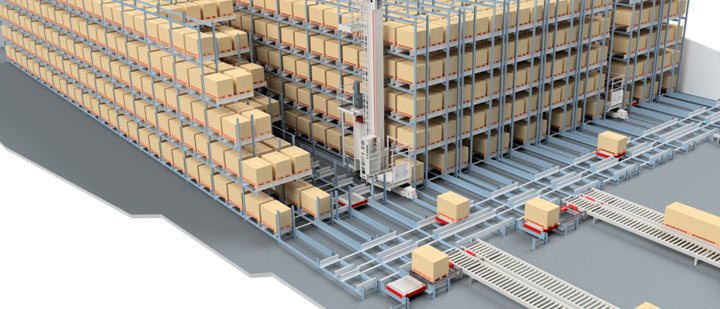Nowadays, success in competition between companies is mainly determined by the flexibility and effectiveness of the storage systems used in the plant, as they represent enormous investment costs and a possible bottleneck when it comes to reacting to fluctuations or high peaks at short notice. The three determining parameters when choosing a bearing are cost, throughput and space utilization. For pallet warehouses, i.e. warehouses with heavy loads, there are no solutions today with which these three parameters can be optimized satisfactorily at the same time. On the one hand, high-bay racking served by stacker cranes (SRMs) is very space-saving, but too slow and does not allow efficient sequencing of goods, so that a pre-zone is required for sequencing with manually operated forklifts. On the other hand, there are storage systems that are operated by One Level Pallet Shuttles (OLPS), i.e. shuttle vehicles that move on rails in both directions on the level and can change floors with lifts. These warehouses allow high efficiency and low space requirements, but are expensive.
The aim of the R&D project "PALSA" is to develop a high-bay warehouse which is served by storage and retrieval machines for pallets with a high degree of space utilisation and which has an OLPS warehouse at the lowest level as a buffer/sequencer. The following requirements will be met by the innovative storage system:
- Fast pallet pickup (many trucks deliver simultaneously);
- Tour-suitable assembly (many trucks depart simultaneously);
- No space-intensive storage pre-zone;
- High throughput;
- High storage capacity;
- Low investment costs;
- Scalability (expansion with customer sales increase);
- Flexibility for different customer requirements;
- Low operating costs (electricity, maintenance).
Starting with a comprehensive analysis of the existing channel storage systems, sorting buffers/sequencers, shuttle storage systems, stacker cranes, hybrid combinations of these components and the control methods (Working Package 1) in the literature and on the market, the development of a rough concept of the material flow, the new system components and the control (WP2) takes place. Based on this overall concept, a functional specification is drawn up (WP3). On the basis of this requirement specification the development of the overall process flow and the system simulation is carried out by the software Plant Simulation (WP4) and parallel the development of the system components including rough strength calculation (WP5). The RBG is further developed from the material flow simulation and the component development (WP6). The system components, the control technology and the control algorithms are then coordinated (WP7, WP8). At this point it is possible to build a prototype (WP9) and test it (WP10). Finally, the system is optimized on the basis of the tests (WP11) and the final technical documentation (WP12) is created.
The project is carried out in cooperation with GEBHARDT Fördertechnik GmbH.
Further information can be found under the following link: marketing.gebhardt-foerdertechnik.de
